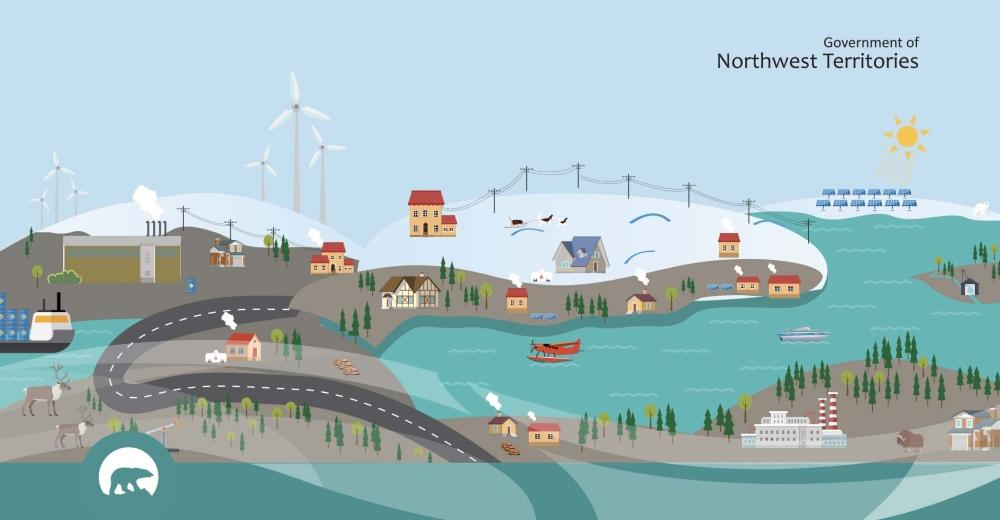BACKGROUNDER: 2022-2025 Energy Action Plan
Released in 2018, the 2030 Energy Strategy sets out the Government of the Northwest Territories’ (GNWT) long-term approach to supporting secure, affordable and sustainable energy supply and use in the NWT.
The strategy guides the development of affordable, reliable and sustainable energy for transportation, heat and electricity. This includes support for energy efficiency and conservation programs, renewable and alternative energy programs and large-scale energy projects.
The GNWT implements the Strategy through three-year Action Plans. This approach allows the GNWT to adapt and be flexible and take advantage of new technologies and opportunities as these emerge. The 2019-2022 Energy Action Plan ended on March 31, 2022. The 2022-2025 Energy Action Plan builds on the actions and initiatives from the previous plan and describes what we plan to do over the next three years.
How the 2022-2025 Energy Action Plan was developed
To develop the 2022-2025 Energy Action Plan, the GNWT reviewed the previous plan and looked for ways to improve on our success and address the gaps that we identified.
The GNWT undertook a public engagement campaign to seek broad input, including:
-
A call for public feedback on the GNWT’s online engagement portal. Residents were asked to submit their ideas that could help the NWT meet its long-term vision of secure, affordable, and sustainable energy while transitioning to a lower carbon economy.
-
Letters sent to Indigenous governments and Indigenous organizations requesting their input on the 2022-2025 Energy Action Plan.
-
Meetings with other GNWT departments, agencies, Crown corporations, Arctic Energy Alliance (AEA), as well as stakeholder groups.
The GNWT also got seven submissions from industry, non-profit organizations and individuals during the engagement period. Most of these submissions had extensive ideas aimed at reducing energy costs for Northerners and businesses while advancing greenhouse gas (GHG) emissions reductions in the electricity, transportation, buildings and industrial sectors.
What is in the 2022-2025 Energy Action Plan
The new three-year Action Plan supports the Strategy by setting out actions and initiatives that will help the GNWT and its partners achieve the six strategic objectives outlined in the Strategy. It includes grants and rebates for a variety of energy and GHG reduction projects, supports for communities and advances major energy projects.
The 2022-2025 Energy Action Plan includes 68 proposed actions and initiatives. The previous Action Plan had 44 actions and initiatives. The 24 additional actions and initiatives – combined with the existing ones in both plans – are expected to reduce GHG emissions by 51 kilotonnes by 2025.
Some key additional actions include:
-
Continued core and enhanced support for existing Arctic Energy Alliance (AEA) programs and services.
-
New core funding to support the Electric Vehicle Rebate program, which will now include support for e-bicycles, and electric on-the land vehicles as they emerge on the market.
-
New support for a low-income energy program though the AEA
-
Additional home energy evaluation capacity for the AEA to meet public demand.
-
New support to advance an electric vehicle fast charger corridor in the NWT between Yellowknife and the NWT-Alberta border.
-
New support for community energy planning and a youth energy mentorship to help communities build capacity and plan projects.
-
Replacement of, and re-investment in, the GHG Grant Programs for NWT governments, communities, residents, building owners, businesses and industry.
-
Continued focused investments in our electricity system to ensure cost increases are offset, the system remains reliable, and reliance on diesel generation is reduced.
Some transformational projects such as electric vehicle charging stations will deliver more emissions reductions after 2025 as Northerners adopt more electric vehicles and usage of charging stations increases. Long-term projects such as transmission lines will also deliver emissions reductions when commissioned after 2025.
Many of the 68 proposed actions and initiatives in the new Action Plan are dependent on continued federal funding. Continued support from the Government of Canada is critical to achieve the strategic objectives of the Strategy and fulfill our commitment to the Pan Canadian Framework on Clean Growth and Climate Change.
The GNWT committed to a full review of the Strategy after five years. This review will take place in 2023-2024. This timeline gives the GNWT enough time to re-evaluate the Strategy’s strategic objectives to make sure they represent what is achievable given new technologies, opportunities and available funding. The GNWT will be looking for input from NWT residents, Indigenous governments and Indigenous organizations, businesses and stakeholders to inform this review.





